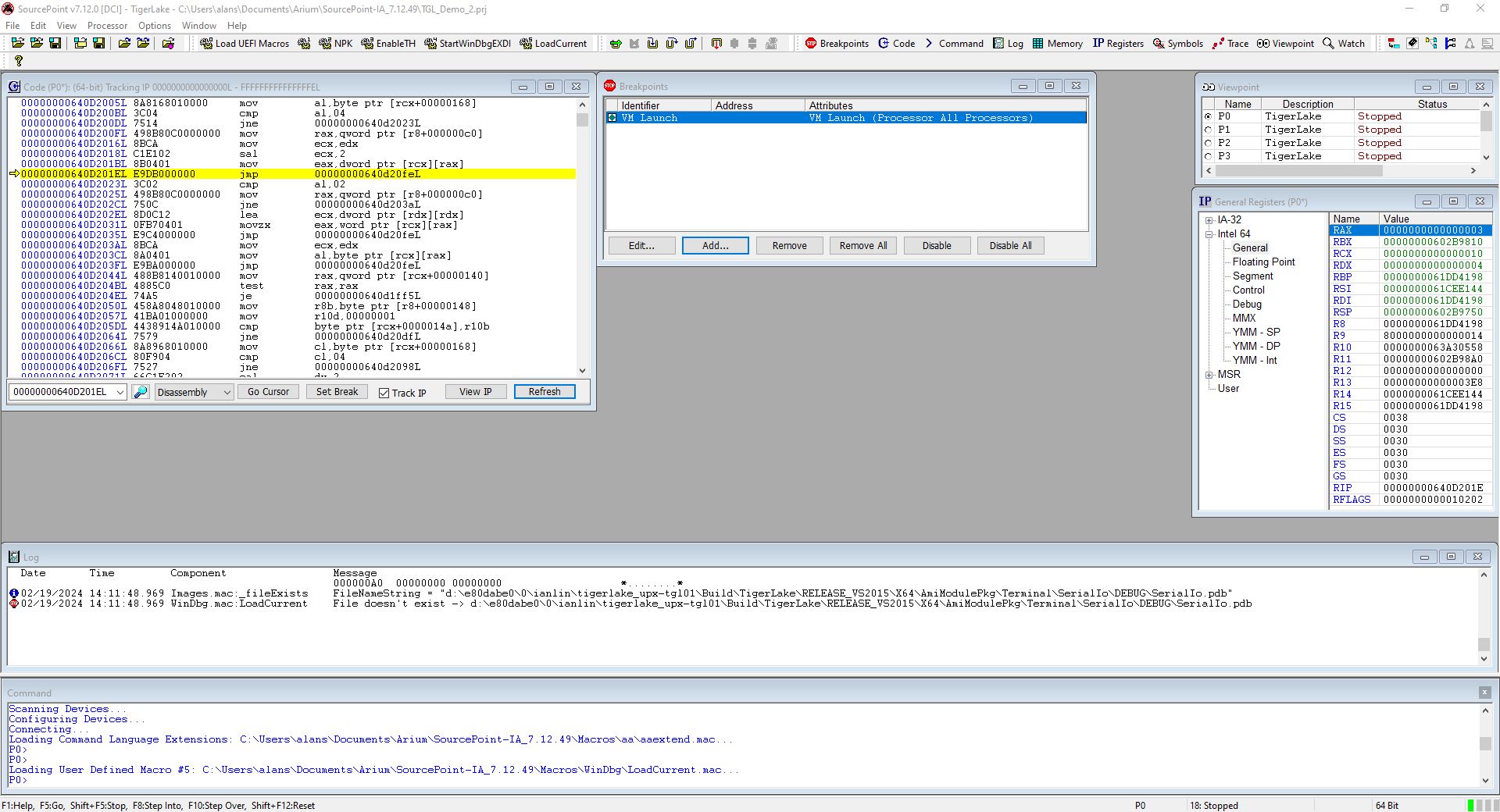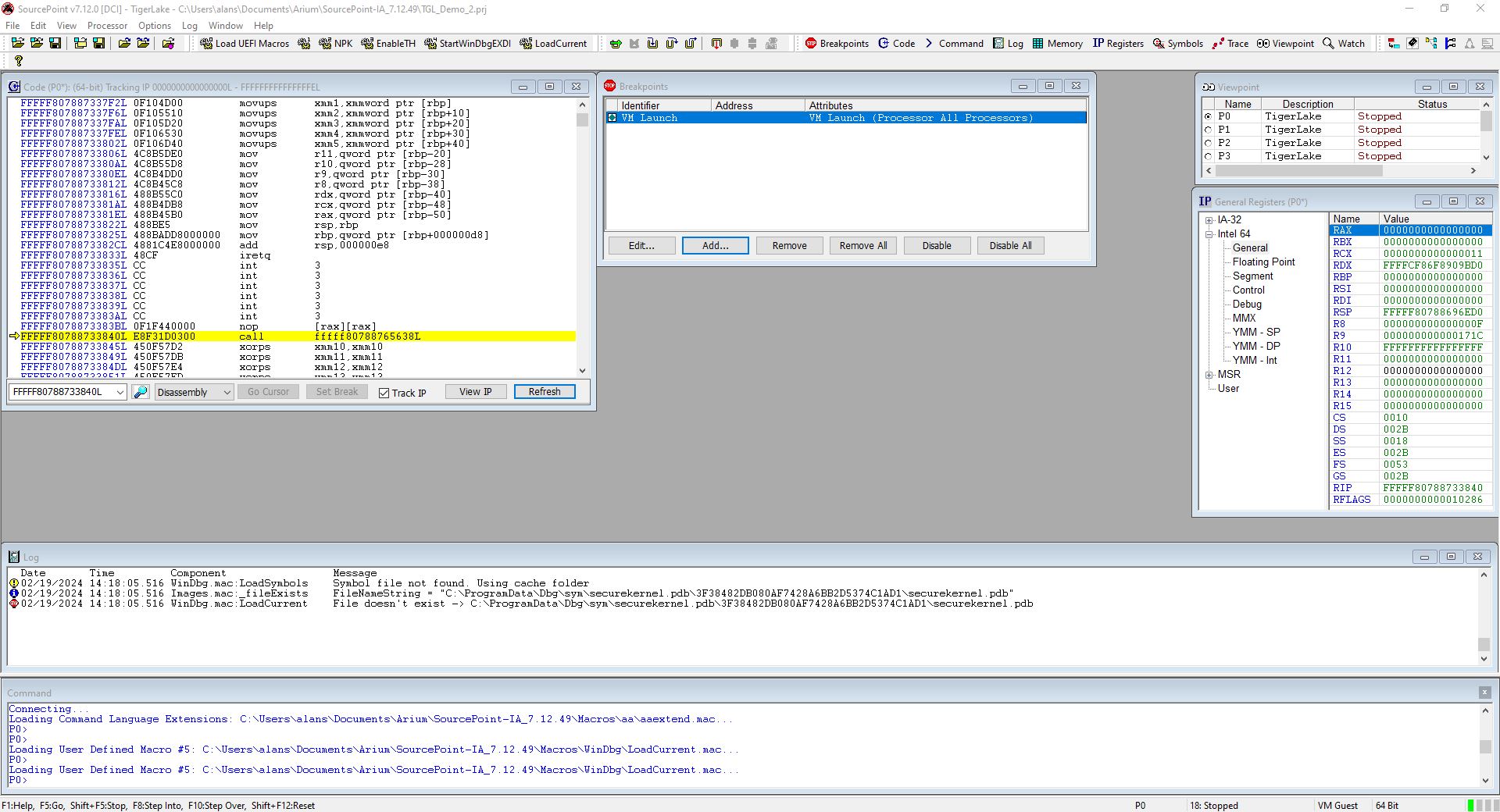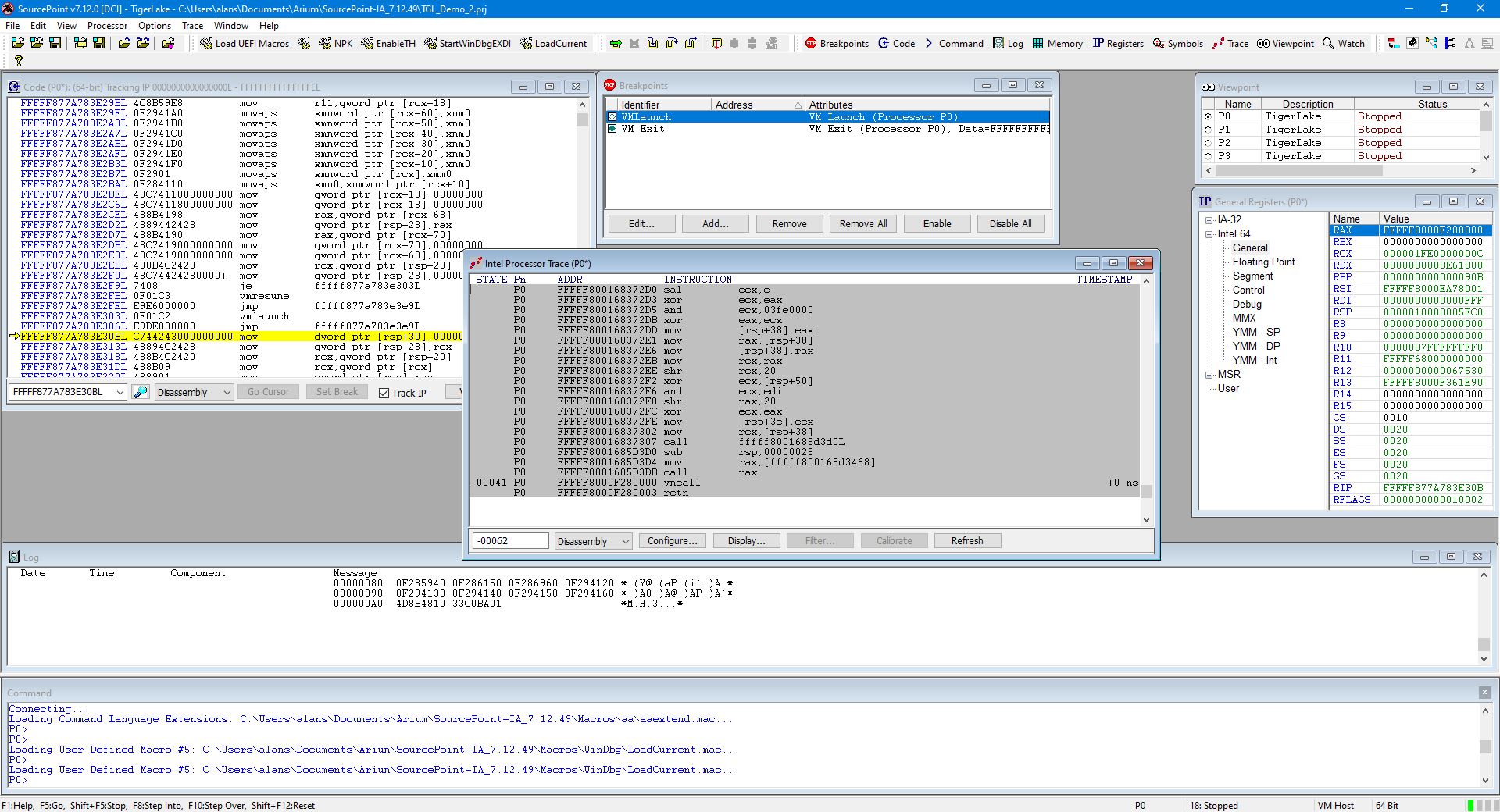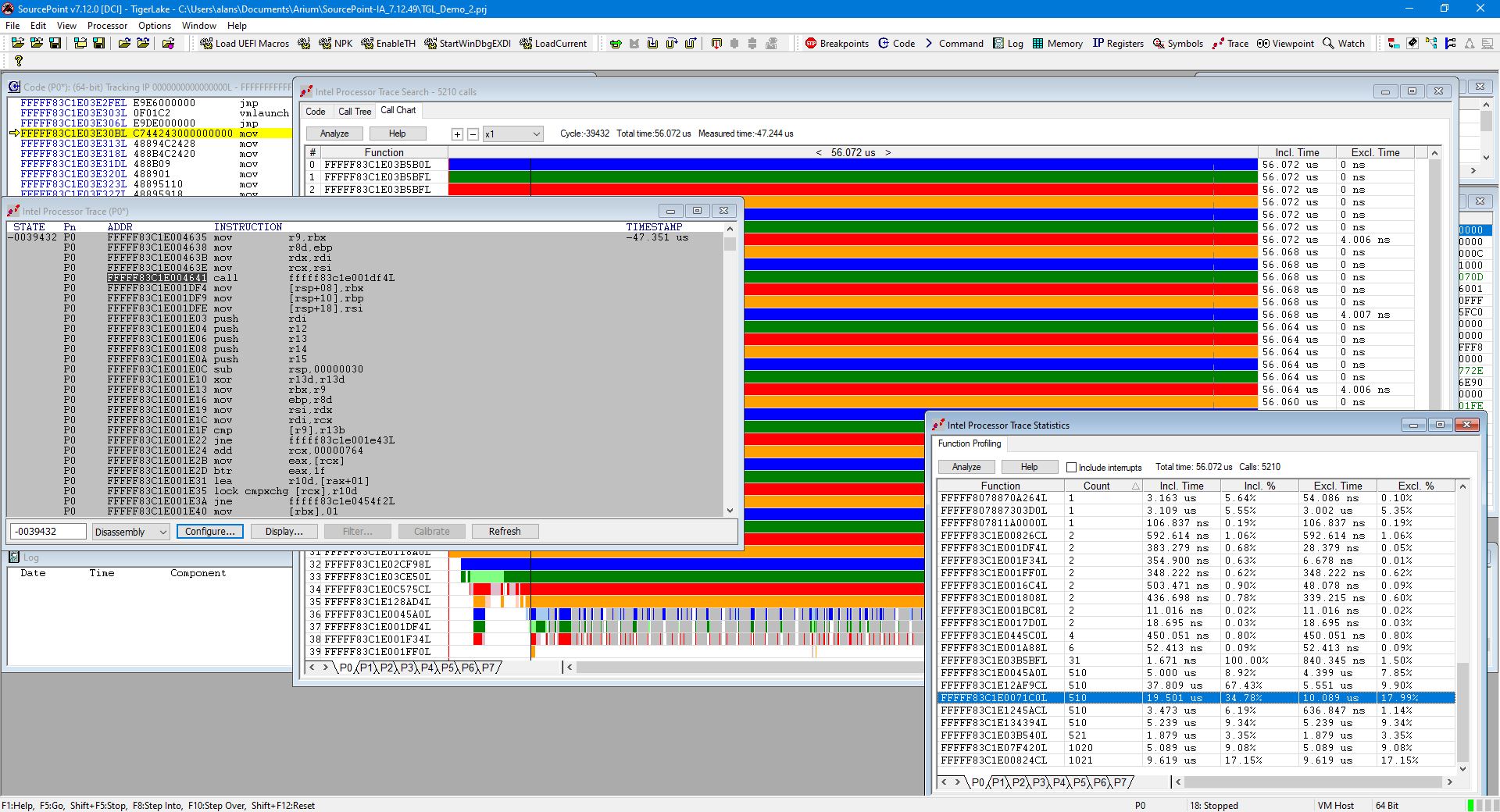In Part 1 of this article series, I demonstrated the use of EXDI with DCI to explore the Windows hypervisor. In this article, we’ll take a first look at the Windows Secure Kernel.
In the first of this series, JTAG debug of Windows Hyper-V / Secure Kernel with WinDbg and EXDI: Part 1, we used the SourcePoint WinDbg tool to set VM Launch and VM Exit breakpoints, and then Intel Processor Trace to capture some of the instructions executed as we booted to Windows. Let’s look at these in more detail now.
As with before, we booted our AAEON UP Xtreme i11 board to the UEFI shell, then took control with SourcePoint with Intel Direct Connect Interface (DCI). After setting SourcePoint’s built-in VM Launch and VM Exit breakpoints, and turning on Intel PT, we ultimately ended up at the Windows desktop, and found ourselves in the hypervisor module (hvix64, for which we have no symbols, of course).
Editor’s note: the AMD equivalent of Intel’s hvix64 is hvax64.
Before we going through the steps necessary to debug and trace the low-level secure kernel and hypervisor code, it’s worthwhile just going through a quick intro of what we’ll be looking at.
The use of hypervisors at the foundation of modern operating systems is an innovation that has been driven by cybersecurity requirements. A hypervisor, by its very nature, is a specialized component of the modern OS that has privileges even higher than the kernel itself. Microsoft’s Hyper-V virtualization technology is used in a set of services entitled Virtualization-Based Security (VBS), that is the foundation of Device Guard, Hyper Guard, Credential Guard, and others.
The Windows HV manifests itself in Virtual Trust Levels (VTLs), specifically VTL-0 (normal kernel) and VTL-1 (secure kernel). Visually, the architecture of the “new” Windows looks like this:
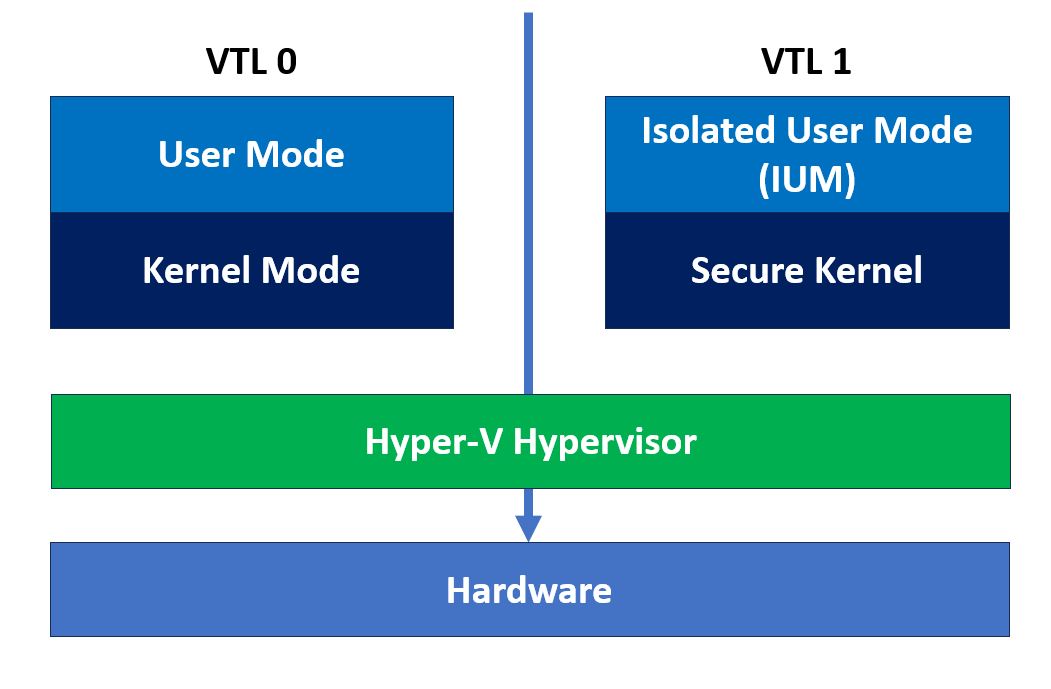 If you’d like know more, I highly recommend the Windows Internals books. Also, Satoshi Tanda has published a number of related articles that are of great interest: https://tandasat.github.io/blog/.
If you’d like know more, I highly recommend the Windows Internals books. Also, Satoshi Tanda has published a number of related articles that are of great interest: https://tandasat.github.io/blog/.
To investigate these using SourcePoint, we’ll take steps one at a time:
As before, boot to the UEFI shell, connect to the target with SourcePoint over DCI, insert a VM Launch breakpoint:
It is worthwhile noting that running the SourcePoint “LoadCurrent” macro gives you the build directory and the module name of the code that is at the current instruction pointer. I didn’t do the build, so I don’t have the source/symbols for this Tiger Lake board:
02/19/2024 14:11:48.969 Images.mac:_fileExists FileNameString = "d:\e80dabe0\0\ianlin\tigerlake_upx-tgl01\Build\TigerLake\RELEASE_VS2015\X64\AmiModulePkg\Terminal\SerialIo\DEBUG\SerialIo.pdb" 02/19/2024 14:11:48.969 WinDbg.mac:LoadCurrent File doesn't exist -> d:\e80dabe0\0\ianlin\tigerlake_upx-tgl01\Build\TigerLake\RELEASE_VS2015\X64\AmiModulePkg\Terminal\SerialIo\DEBUG\SerialIo.pdb
See my earlier blogs for more information on the AAEON Whiskey Lake board, which, with some work, does have Tianocore UEFI source/symbols available:
Back to the Tiger Lake board: then run the target until the VMLaunch breakpoint is hit:
We can now debug the Secure Kernel (note from the Log window that the “LoadCurrent” macro cannot find the PDB, which is as expected):
02/19/2024 13:34:55.710 Images.mac:_fileExists FileNameString = "srv*\securekernel.pdb\3F38482DB080AF7428A6BB2D5374C1AD1\securekernel.pdb" 02/19/2024 13:34:55.711 WinDbg.mac:LoadSymbols Symbol file not found. Using cache folder 02/19/2024 13:34:55.711 Images.mac:_fileExists FileNameString = "C:\ProgramData\Dbg\sym\securekernel.pdb\3F38482DB080AF7428A6BB2D5374C1AD1\securekernel.pdb" 02/19/2024 13:34:55.711 WinDbg.mac:LoadCurrent File doesn't exist -> C:\ProgramData\Dbg\sym\securekernel.pdb\3F38482DB080AF7428A6BB2D5374C1AD1\securekernel.pdb
Debugging the Secure Kernel using SourcePoint WinDbg is fairly straightforward. All the standard run-control features work: single-step, Go To Cursor, set breakpoints, etc. Editor’s Note: for some reason, it is difficult to capture instruction trace (either LBR or Intel PT) leading up to the initial VMLaunch breakpoint – we’re working on it.
Note that SourcePoint says, at the bottom right, that the Secure Kernel is running in VM Guest mode. I find that interesting.
To see the first instantiation of the exit to the root partition, we uncheck the VM Launch breakpoint, and set a VM Exit breakpoint. We can then also turn on Intel PT. Then hit Go:
Note that we’re in VM Host mode.
Just for interest’s sake, here’s a snippet of instruction trace preceding the actual break:
P0 FFFFF80673107264 jne fffff80673107256L P0 FFFFF80673107256 mov [rdx],rax P0 FFFFF80673107259 inc rax P0 FFFFF8067310725C lea rdx,[rdx+08] P0 FFFFF80673107260 sub rcx,00000001 P0 FFFFF80673107264 jne fffff80673107256L P0 FFFFF80673107256 mov [rdx],rax P0 FFFFF80673107259 inc rax P0 FFFFF8067310725C lea rdx,[rdx+08] P0 FFFFF80673107260 sub rcx,00000001 P0 FFFFF80673107264 jne fffff80673107256L P0 FFFFF80673107256 mov [rdx],rax P0 FFFFF80673107259 inc rax P0 FFFFF8067310725C lea rdx,[rdx+08] P0 FFFFF80673107260 sub rcx,00000001 P0 FFFFF80673107264 jne fffff80673107256L P0 FFFFF80673107266 jmp fffff80673107283L P0 FFFFF80673107283 mov ecx,0000000c P0 FFFFF80673107288 lea rax,[rsp+44] P0 FFFFF8067310728D mov rdx,rdi P0 FFFFF80673107290 cmp ebx,ecx P0 FFFFF80673107292 ja fffff806731072b6L P0 FFFFF806731072B6 mov [rsp+28],rax P0 FFFFF806731072BB xor r9d,r9d P0 FFFFF806731072BE xor r8d,r8d P0 FFFFF806731072C1 mov [rsp+20],ebx P0 FFFFF806731072C5 call fffff806730f7264L P0 FFFFF806730F7264 mov [rsp+08],rbx P0 FFFFF806730F7269 push rdi P0 FFFFF806730F726A sub rsp,00000020 P0 FFFFF806730F726E xor ebx,ebx P0 FFFFF806730F7270 mov rax,r8 P0 FFFFF806730F7273 mov r8,rdx P0 FFFFF806730F7276 mov rdi,0000fffffffff000 P0 FFFFF806730F7280 mov edx,ebx P0 FFFFF806730F7282 mov r10,0000007ffffffff8 P0 FFFFF806730F728C mov r11,fffff68000000000 P0 FFFFF806730F7296 test r8,r8 P0 FFFFF806730F7299 je fffff806730f72a9L P0 FFFFF806730F729B shr r8,9 -833.333 ns P0 FFFFF806730F729F and r8,r10 P0 FFFFF806730F72A2 mov rdx,[r8][r11] P0 FFFFF806730F72A6 and rdx,rdi P0 FFFFF806730F72A9 mov r8,rbx P0 FFFFF806730F72AC test rax,rax P0 FFFFF806730F72AF je fffff806730f72bfL P0 FFFFF806730F72BF movsxd rax,ecx -517.494 ns P0 FFFFF806730F72C2 mov edi,00000fff P0 FFFFF806730F72C7 mov [rsp+38],rax P0 FFFFF806730F72CC lea ecx,[r9+07] P0 FFFFF806730F72D0 sal ecx,e P0 FFFFF806730F72D3 xor ecx,eax P0 FFFFF806730F72D5 and ecx,03fe0000 P0 FFFFF806730F72DB xor eax,ecx P0 FFFFF806730F72DD mov [rsp+38],eax P0 FFFFF806730F72E1 mov rax,[rsp+38] P0 FFFFF806730F72E6 mov [rsp+38],rax P0 FFFFF806730F72EB mov rcx,rax P0 FFFFF806730F72EE shr rcx,20 P0 FFFFF806730F72F2 xor ecx,[rsp+50] P0 FFFFF806730F72F6 and ecx,edi P0 FFFFF806730F72F8 shr rax,20 P0 FFFFF806730F72FC xor ecx,eax P0 FFFFF806730F72FE mov [rsp+3c],ecx P0 FFFFF806730F7302 mov rcx,[rsp+38] P0 FFFFF806730F7307 call fffff8067311d3d0L P0 FFFFF8067311D3D0 sub rsp,00000028 P0 FFFFF8067311D3D4 mov rax,[fffff80673193468] P0 FFFFF8067311D3DB call rax P0 FFFFF8066BB70000 vmcall +0 ns P0 FFFFF8066BB70003 retn
This is a tiny fraction of the possible code trace. A 16kB Intel PT buffer can contain 10s of microseconds of execution trace. In practice, we can create as large a buffer as want (2GB is do-able). It just takes proportionately longer to extract the data from target system RAM for display and analysis. Note that the instruction flow is timestamped.
Even though we don’t have the securekernel.pdb and hvix64.pdb symbol files, we can look at the Call Tree to see a visual display of where the hypervisor is spending its time:
The timing profile is fascinating. Look at the SourcePoint Intel Processor Trace window, the Intel PT Search Call Chart, and the Intel PT Statistics window. There’s a lot to be learned here.
In an upcoming blog, I’ll write about researching the Secure Kernel and Hypervisor using both Intel PT and Architectural Event Trace (AET). Using these two trace technologies together will allow us to capture events such as interrupts, MSR reads and writes (especially useful for machine checks), SMI, NMI, and others, all with instruction trace so we can see the code executed leading up to the event. AET in particular also supports Code and Data breakpoint events: these implement microarchitectural changes in Intel CPUs that treat breakpoints as events, and don’t actually halt the target. If you want to see AET in action, I’d recommend the webinar I did a few years ago with the UEFI Forum: UEFI Debug with Intel Architectural Event Trace. Starting about 25 minutes in is the demonstration of an AET Code Breakpoint. It’s pretty cool.


